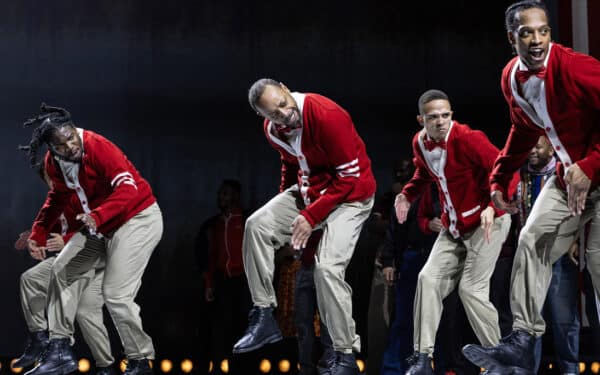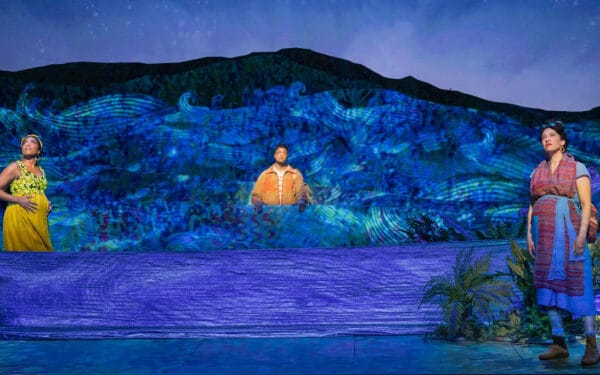The RhineBling, at English National Opera (ENO) is super-glam. It says on the programme the production is in cooperation with Germany, the travel destination. More like Brink’s Mat, the infamous Hatton Garden 1983 bullion robbery. The greatest gold heist of all time. £26m. In today’s money £80m.
“There’s gold in that there London Coliseum”. From my experience at Sunday’s matinee, possibly all that remains unrecovered from the Brink’s Mat haul. That would be about half of it. For it was bling everywhere in this otherwise rather unostentatious production of Richard Wagner’s The Rhinegold from director, Richard Jones.
Jones, who sharpened his wits in Glasgow’s Citizen’s Theatre and Scottish Opera, is acknowledged to have a ready wit and “a gift for the gaudy and the wayward”, according to David Pountney, a controversial legend of 1980’s opera productions.
Unlike many directors who slash, burn and shock just to reinforce wild child reputations, Jones, while always challenging, remodels the familiar, fine-tuning to modern times. This production is familiar to the audience’s ear.
So, out with Wagnerian horns, swords and stand-up arias. In with simple costumes – although the Rhine Maidens in luminous running lycra were a bit much – and sharp irony in every scene. When Alberich tricks the Rhine Maidens in the opening sequence and liberates the gold from the murky depths, it turns out to be in the form of a horribly realistic, misbehaving golden infant.
So well-constructed and mobile that, for a moment I had a double take. Surely they hadn’t actually sprayed some kid? Call Child Protection! Of course, it was just a cleverly manipulated mannequin. Much more imaginative than the yellow rubber duck I saw at Bayreuth a few seasons ago.
We are in full-on “gold” season in Britain. Coincidentally, BBC’s The Gold, currently running on BBC iPlayer – an addictive, binge watch about the Brink’s Mat raid – leaves off with £13m worth of bullion still missing.
Is that a sequel I smell? Now I can tell Hugh Bonneville – who plays Brian Boyce, dogged detective tracker of the south London villains and the legend who put his hand on the shoulder of Reggie Kray – where his elusive loot is stashed. Psst! ….. Hugh, it’s been at the Coliseum all along.
Send a Flying Squad Ford Granada pronto. ENO is laundering it manically as props. First, there’s the gold child. Then, after forging the magic gold ring, Alberich, vertically challenged Lord of the Nibelung tribe, sets up an underground industrial recycling operation – dead ringer for the Brink’s Mat gang’s John Palmer’s smelter in his garden shed.
Next, the loot is piled high on stage. Gold bars – serial numbers removed of course – float, stack and tumble, projected on a screen. All that’s missing is the number of the Valhalla offshore account to launder the proceeds.
The giants, Fafner and Fasolt, dodgy builders of Wotan’s even more dodgy Valhalla property scam, remove a load of pallets stacked with gold bars in a low loader Luton van. True to the tradition of London villains they fall out. Fafner clubs Fasolt to death because he’s fallen in love with Freia, their hostage standing surety for Wotan’s debts.
The clubbing scene was a failure. Fasolt is pushed offstage left during the struggle, only to be pulled back a second later and brutally whacked about the head by Fafner. Of course, it’s not Fasolt. Obviously, a dummy pinched from nearby Lipman the Tailors’ window. Thankfully, this was the only moment Jones reducedWagner to Punch and Judy.
For readers who require a full introduction to this opening chapter of Wagner’s Ring Cycle, a synopsis can be found here. From curtain up it’s obvious Jones has something other than Wagner’s Norse legend on his mind. We are not being treated to the composer’s concept of Gesamtkunstwerk, the great artwork of the future that was meant to underpin the myth of Germany as the only valid source of sublime art.
Jones delivers a much more topical and entirely believable contemporary narrative. The Gods are arriviste social climbers. Wotan first appears, nude, dragging a tree across the stage, then reappears wearing a modest loin cloth, hauling a well-trimmed trunk, then even more properly dressed, with little more than a branch and finally, as a purple-suited Wotan with a carefully crafted spear shaft to which he adds the metal head.
Upwardly mobile, he has gained his godly totem. He has to work at it. The message is that Wotan is the very model of a modern self-made God. His Valhalla will be a gated complex on Spain’s Costa Brava. Not the shining mythical castle in the sky Wagner intended.
Wotan heads a troupe of Gods. Fricka, his long-suffering trophy wife, Froh, the God of sunshine, Donner, God of thunder and quick-tempered brother of Freia, goddess of beauty and golden apples. The apples guarantee the whole bunch youth.
When she has been handed over by Wotan to the giants as security for payment on completion of Valhalla there is a hilarious moment when all the Gods emerge, processing across the stage, decrepit, with shocks of white hair. An apple a day keeps dotage away.
In traditional versions of The Ring Cycle, the Gods start out as omnipotent. At the end of the cycle, Götterdämmerung, their kingdom is destroyed. But Jones has them standing on uncertain ground from the start. If the cycle is ever complete it will be interesting to see how Jones develops that edgy feel in the following operas, Siegfried and Götterdämmerung. If he gets the chance.
The Valkyrie, also produced by Jones, was delivered out of sequence in 2021, to mixed reviews. Why show it first? Valkyrie has the famous tune and puts more bums on seats.
Shaping characters slightly differently from what is traditionally expected is a Jones skill. Loge, the demi-god of fire, who is usually Wotan’s servant, is portrayed more as an “influencer”, dodging hither and thither between Wotan, the giants and Alberich’s underworld.
His lime-coloured gloves probably detract from his influence as much as they add to his visibility. He’s the sort of worthless therapist who flitted around Diana Princess of Wales and no doubt graces the dinner table at Harry and Meghan’s Montecito mansion.
Loge was sung by Frederick Ballentine, an American tenor, who was one of the stars of the show, flitting manically hither and thither, assuming the fixer role Jones assigns him perfectly.
At the start, the scenery looked almost non-existent and downright weird. A back curtain – and then a front curtain – of long strips of glittering foil. Strange interconnected white globes, perhaps leftovers from a Royal Institution Christmas lecture on molecular structure. Were moved about randomly. Maybe Stewart Laing, Designer, had done a dodgy off-season deal with Poundland’s Christmas Grotto department.
But, as the sparkling fly screens got to work, ascending and descending to frame the changing scenes, they proved highly effective. And, when in the closing moments the Gods crossed the bridge to Valhalla, the prolonged backdrop of spinning, sparkling foil that descended behind them, forming a spectacular, reflecting waterfall of colour, the themes of the scenery joined up.
Valhalla turns out to be more a bleak, grey bunker than a dream house. The Gods are portrayed as being in retreat, securing the windows against the furious Rhine Maidens and locking the door with an enormous wheeled lock as found on impregnable safes, or submarine hatches. They are going to find it hard to rule the troublesome world below from there.
The ENO orchestra clearly relished its encounter with Wagner’s score. Martin Brabbins, the musical director, seemed in his element. No-one can accuse ENO of not being able to deliver Wagner.
Locating percussion and harps in boxes adjacent to the stage gave the sound a full effect. Amplified surround sound was, sparingly thank goodness, used. It didn’t really work. Just a gimmick.
John Deathridge, a writer and Wagner expert, did a deft job polishing up the libretto. He brought it up to date while avoiding ugly slang. The surtitles were barely necessary. A litmus test for English language ENO.
The cast was well balanced. John Relyea, portrayed the conflicted Wotan perfectly; Leigh Melrose was a suitably agitated Alberich; Madeleine Shaw, a sceptical Fricka; and John Findon, the put upon Mime. The full cast can be found here.
Shout out for Erda, Christine Rice. The Goddess of the Earth has a small, but influential part. The English mezzo-soprano is Wotan’s link with the world below. She sang lusciously – to Fricka’s extreme annoyance.
If you are a hard-line, traditional Wagner fan and favour the Nordic hero approach, this ENO The Rhinegold is clearly not for you. But your dilemma is, you are unlikely to find any of the Ring Cycle’s four operas satisfying your taste anywhere. No-one is doing the shouty-helmet thing these days.
The last traditionalist effort I recall is a Metropolitan Opera production pre Covid. Director, Robert Lepage’s infamous setting, with the ever moving 24 clanking piano-key set was spectacular, but cost $35m to mount. And, apparently the set is now unusable, rusting away in warehouses in Canada.
The days of such extravagant productions are done. ENO’s intelligent approach is an inevitable response whenever The Ring is to be performed as a full cycle. This ENO production set out as a joint effort with the Met, but the recent Arts Council axe applied to ENO’s budget has put paid to that.
It is a terrible loss. The joint venture – as with Philp Glass’ Akhnaten – promised so much and was a feather in ENO’s cap. A well-deserved international endorsement.
It beggars belief that a well-run opera company, capable of producing work of this originality and quality, is facing the chop, albeit delayed. I looked carefully around The Coliseum. Almost full capacity at a matinee performance on a Sunday afternoon. That’s a real benchmark of ENO’s success.
The seemingly endless cascade of fluttering coloured origami, winking in the spotlights, eventually petered out, leaving a thick, reflecting carpet on the stage. Later, I asked Dominic Haddock, ENO’s overworked Head of Philanthropy, what on earth they did with the rainbow mountain after each performance. He solemnly explained that it was gathered up carefully for recycling,
But, of course, it could not be used again by ENO for future rainbows. For the simple reason that all the colours had mixed. No-one at ENO with time to rake through the pile. Ominously, ENO has a buyer who deals in scrap rainbows. Examine your next set of Christmas decorations carefully. This year you could be festooning that family Christmas tree with pure RhineBling.
Write to us with your comments to be considered for publication at letters@reaction.life





